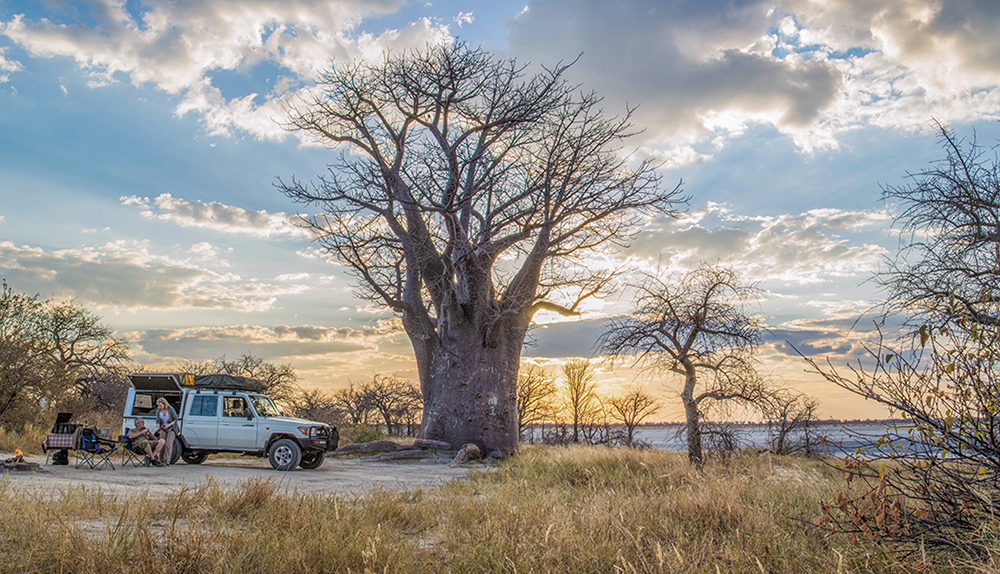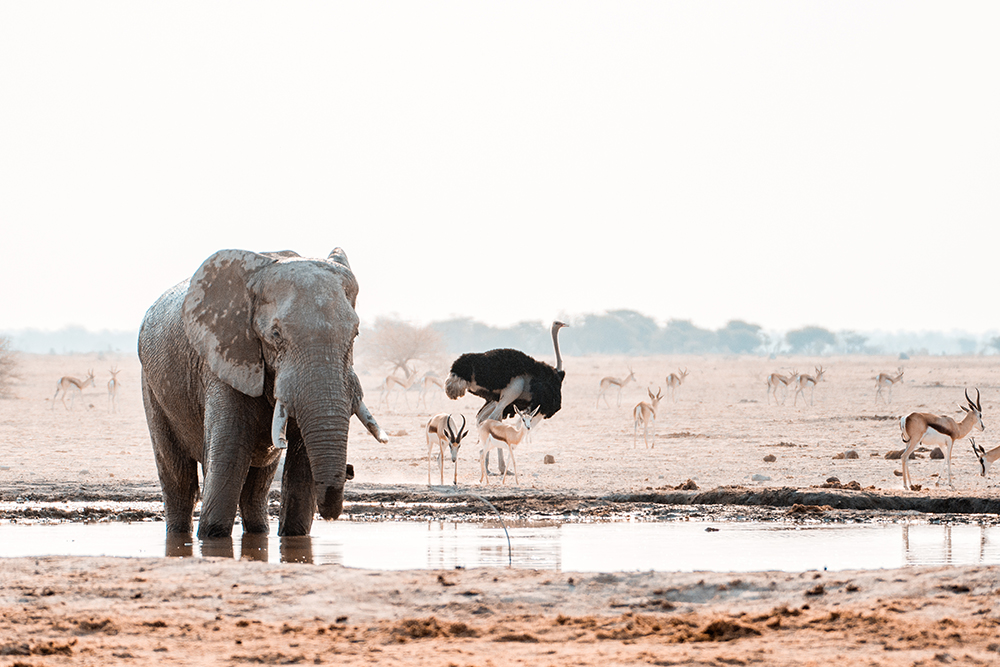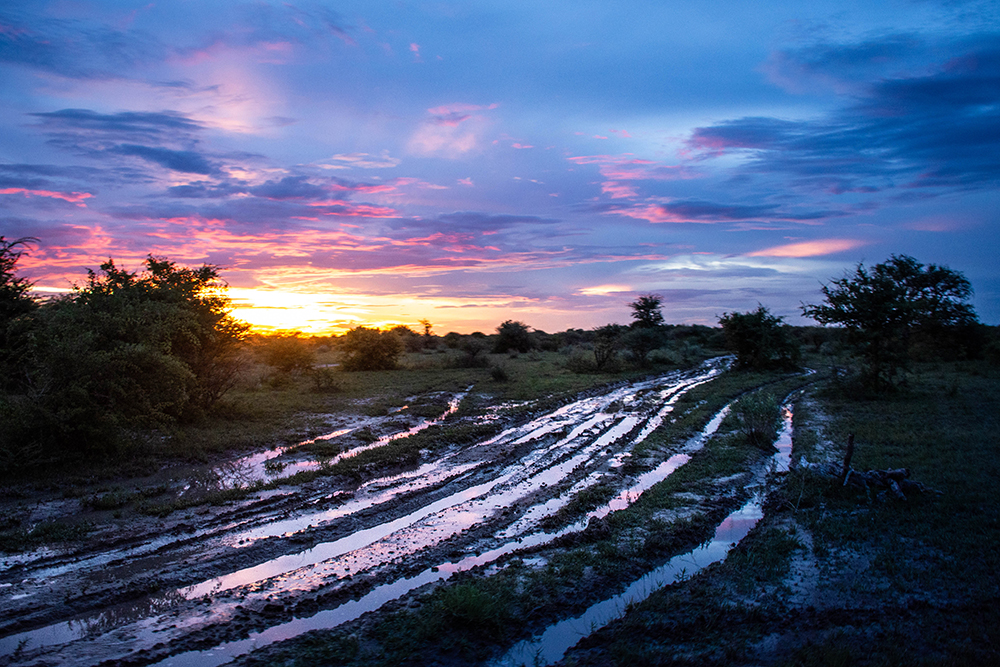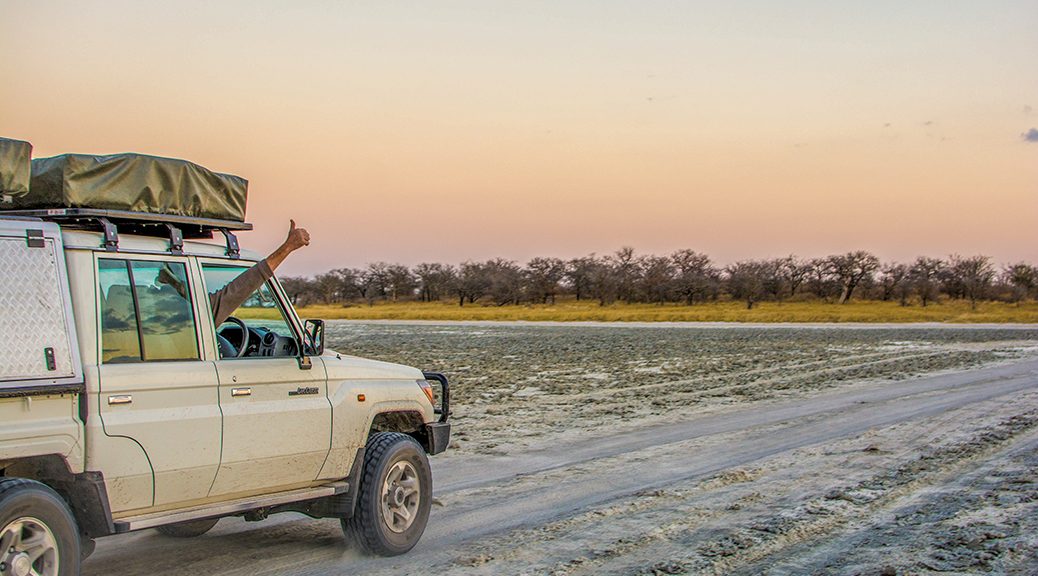Although little, Botswana’s Nxai Pan National Park packs a surprising punch. It’s home to elephants, lions, jackals, bat-eared foxes, zebra, impala and springbok (the only place in the country where both antelope species occur) – and the sublime scenery of Baines’ Baobabs. Nxai Pan is not just a tremendous itinerary addition, but a destination in its own right. By Melanie van Zyl
There’s little like the abundant space of the otherworldly Makgadigadi Pans. Did you know, that the Makgadigadi, which translates to “place of many pans”, applies to a sprawling network of pans? It’s made up of three smaller salt pans, namely the Sowa, Ntwetwe and Nxai pans. Nxai Pan forms the northernmost boundary of this system. Declared 50 years ago and extended in 1992 to include Baines Baobabs, Nxai Pan National Park is also one of the most accessible parks in Botswana, although you’ll still need a 4X4.
I’ve been to this park four times and I’m hankering for another return. The first adventure was a short overnight at Baines Baobabs with my folks. We shot into the park for a sunset drive past the bellies of the broad woods and spent a cool night below the stars in campsite one. My second experience was a drastic change in seasons. In January, the park was a hot, muddy mess of green grasslands and frisky young animals. The sloshing networks of wet roads in the north prove formidable in the rains and I was grateful to be guided at this time, trusting my experience to the capable hands of the park’s only permanent lodge. Most recently, I tackled the park with two friends on a self-drive adventure. Three women and one Toyota Fortuner. If we can manage, anyone can.
The road is tarred right to the gate of the park, which sits on the A3 roughly 130km away from Maun and 65km west of Gweta. (Keep your eyes peeled for police vans on this road; they possess a nifty radar system for scouting out speedsters in the 80km/h zone). Once at the gate, let those tyres down. Soft sand and corrugated tracks will soon alert you to the fact that there’s adventure afoot!
Expert advice: How to take the Tracks4Africa Navigation App off-road in Botswana
Baines Baobabs
Baines’ Baobabs is the closest landmark to the park gate. The only giants and beacons for kilometres, these grand trees drew many travellers crossing the Kalahari. On a journey with David Livingstone (the same mission that later led him to name the mighty waters up north Victoria Falls), landscape painter and naturalist Thomas Baines immortalised this string of baobabs. They camped beneath the trees, and Thomas captured their beauty in watercolour, signing it, “A group of Baobab trees on the north-west spruit of the Mtwetwe pans, May 1862”.

Very little has changed in the 150 years since. The vast cream-coloured Kudiakam Salt Pan sits between a circle of isolated campsites that continue to attract many intrepid travellers looking for sheer isolation. You’ll share it only with the odd elephant in the shade of a baobab, lone gemsbok or the odd jackal.
Where to stay: Book a campsite in advance with Xomaesites. Choose from one of three secluded sites (this detailed guide to camping at Baines Baobabs can help you select the best option). The only facilities here are a pit latrine and bucket shower cubical. You need to bring in all supplies, such as firewood and enough water. Each site can host a maximum of three vehicles and 12 guests per stand.
Contact: +26 76 862 221, xomaesites@btcmail.co.bw, www.xomaesites.com
South Camp
This area is your destination for great game sightings. It takes just over an hour to reach South Camp from the park gate. The biggest attraction here is the iconic waterhole. Sit at the Nxai Pan waterhole for a sundowner, and you’re sure to nab that classic photograph of an elephant spiralling water into the air. Predators lurk in the bushes that surround it, but even in the heat of a winter’s day, it’s a simple pleasure to watch the visiting birds (ostrich, Namaqua sandgrouse and kori bustards are regulars), giraffes and wildebeest herds.

Where to stay: There are 10 shaded campsites to choose from (know that in summer, sometimes these flood!) and they are pretty close together. The shared ablution blocks are usually clean and well-maintained with running water. There is also a small tuck shop for basic supplies. If you’re after privacy, rather stay at Baines Baobabs.
Contact: +2676862221, xomaesites@btcmail.co.bw, www.xomaesites.com
Expert advice: How to book campsites in Botswana’s national parks
Nxai Pan Camp
The only lodge in Nxai Pan National Park, this secluded Kwando Safaris camp is stylish, but minimalist (staying true to the stark environment) solar-powered and scenically positioned. Kwando Safaris is a citizen-owned and run outfit that champions local employment and treads softly on the environment. They offer short bushwalks where guests can gain cultural insights. Learn how ostriches survive in this desert and the tricks to trapping a guinea fowl from the superb San guides. Staying here is a great way to complement a night out at the rustic Baines Baobabs campsites. It’s also a perfect base from which to observe the prolific zebra migration during summer. Opt for a guided game drive if you’d prefer a professional tackle the muddy mess of roads.

Where to stay: Nine environmentally considered chalets overlook a productive waterhole blessed by streams of elephants in the dry season. The lodge provides an all-inclusive stay. Expect homely meals, stargazing sessions and daily game drives.
Contact: +2676861449, info@kwando.co.bw, www.kwando.co.bw
Nxai Pan Travel Tips
- Nxai Pan National Park is open all year, but driving conditions can be tricky and challenging during the ultra-muddy rainy season (Dec–April). Ask about best directions and road conditions at the gate; for example, the new road along the park boundary is better than the old track when heading north.
- December through to April brings rain, epic thunderstorms, greenery, baby animals and beautiful blooms to the otherwise khaki scenery. It’s a fantastic time for photography and seeking out the zebra migration.
- Zebra are present in their thousands and drop their young at Nxai Pan after the rains begin. It is a spectacle worth planning your trip around.
- Winters are mild during the day. Temperatures sit at about 28°C, but once the sun goes down, temperatures can drop to below zero. Bring your winter woollies.
- Draw enough cash in Botswana pula for the park and entry fees.
- There is no fuel available in the park. There is a petrol station at Gweta, but there isn’t always fuel. Fill up at Nata or Orapa if driving from the west.
Have you been to Nxai Pan? Let us know what the highlights and challenges were in the comments below.
For a wealth of information on Botswana, from driving tips and how to deal with borders to unmissable sights and where to stay, check out our Botswana Self-Drive Guide Book. It’s available at 50% discount, on its own or as a combo with the Namibia Self-Drive Guide Book until the end of April 2020.


Fill up at Nata or Orapa (and top up at Rakops which has fuel most of the time) if driving in from the east. Maun if driving in from the west.
I have been to Nxai Pan several times, the last in April 2016. It is a truly amazing place for game, BUT only if you visit at the right time of year – March to May is brilliant for the sheer numbers and variety of game. Zebras by the thousand, herds of giraffe …… and always the predators, there is a resident pride of lions and one visit, saw 2 leopards in broad daylight on the same day! That same lion pride kept us awake one night roaring away just outside our tents – an exhilarating, if not a little nerve racking experience!
And even better, there was never more than one or two other camp sites occupied!!
we went there in 1999 in our first trip ever to botswana ; the camp ablutions were very very basic and dirty ; that was the pattern throughout the trip including in late years of travelling to ckgr for example ; dwnp never impressed me with the way they neglect maintenance and cleanliness of toilettes ; however i have accepted that one pays for the privilege to go and see very wild places and gain in may great experiences! nxai pan was the first one ; we saw many elephants while picking up wood always late afternoon around the vicinity of the water hole ; we had lions on many occasions and the herds of springbok and great flocks of guinea fowl were always there .
Nxai Pan was my first experience of wilderness over 30 years ago. I had previously seen lots of wildlife in South Africa but the Kruger, for example, is just not the same.
We had come up from Jo’burg and overnighted at Nata Lodge on an escorted camping trip.
I walked a short distance away from the camp fire and lay on my back looking up. This is my memory – the sky, the star; how close they seemed, how extraordinary.
Wonderful place. Lots of fun in the rain season!
No relevance though to draw comparison to Kruger, or any other place.